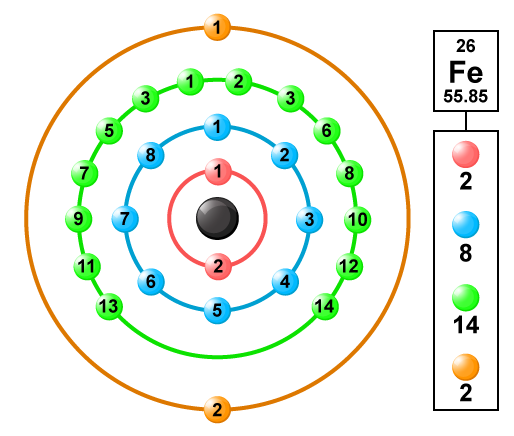
The atomic number of Fe is 26, which means that its atoms contain 26 protons in their nuclei, and if neutral, 26 electrons in their electron clouds. The ground state electron configuration of Fe is: 1s22s22p63s23p63d64s2 If you look at the Aufbau diagram, you can see that the 4s sublevel fills before the 3d sublevel because it has lower energy. Before a name and symbol are approved, an element may be referred to by its atomic number (e.g., element 120) or by its systematic element name. The systematic element name is a temporary name that is based on the atomic number as a root and the -ium ending as a suffix. For example, element 120 has the temporary name unbinilium. How many unpaired electrons are there in Fe3+? Fe (atomic number) - 26 Electronic course of action of fe - 1s2 2s2 2p6 3s2 3p6 4s2 3d6 By losing one electron, it'll become Fe+ - Ar4s1 3d6. ( Ar - 18) By losing two electrons, it'll become fe2+. For Fe when two 4s electrons are removed, it has a +2 oxidation state and electronic configuration of Fe +2 = 1s 2 2s 2 2p 6 3s 2 3p 6 3d 6 Now, the n=3 becomes the outer most shell, iron can lose electrons from this shell as well more specifically from the 3d subshell which has 6 electrons.
Molar mass of Fe = 55.845 g/mol

Convert grams Fe to moles or moles Fe to grams
| Symbol | # of Atoms | Iron | Fe | 55.845 | 1 | 100.000% |
In chemistry, the formula weight is a quantity computed by multiplying the atomic weight (in atomic mass units) of each element in a chemical formula by the number of atoms of that element present in the formula, then adding all of these products together.
All windows sound driver download. Purchase windows 7 32 bit. A common request on this site is to convert grams to moles. To complete this calculation, you have to know what substance you are trying to convert. The reason is that the molar mass of the substance affects the conversion. This site explains how to find molar mass.
If the formula used in calculating molar mass is the molecular formula, the formula weight computed is the molecular weight. The percentage by weight of any atom or group of atoms in a compound can be computed by dividing the total weight of the atom (or group of atoms) in the formula by the formula weight and multiplying by 100.
Formula weights are especially useful in determining the relative weights of reagents and products in a chemical reaction. These relative weights computed from the chemical equation are sometimes called equation weights.
Using the chemical formula of the compound and the periodic table of elements, we can add up the atomic weights and calculate molecular weight of the substance.
What Is Fe Atomic Number
Finding molar mass starts with units of grams per mole (g/mol). When calculating molecular weight of a chemical compound, it tells us how many grams are in one mole of that substance. The formula weight is simply the weight in atomic mass units of all the atoms in a given formula.
Atomic Mass Worksheet Answer Key
/GettyImages-1143649584-04e88f5111ab4417bc8d8e3fe54566ef.jpg)
Fe Atomic Number
The atomic weights used on this site come from NIST, the National Institute of Standards and Technology. We use the most common isotopes. This is how to calculate molar mass (average molecular weight), which is based on isotropically weighted averages. This is not the same as molecular mass, which is the mass of a single molecule of well-defined isotopes. For bulk stoichiometric calculations, we are usually determining molar mass, which may also be called standard atomic weight or average atomic mass.
